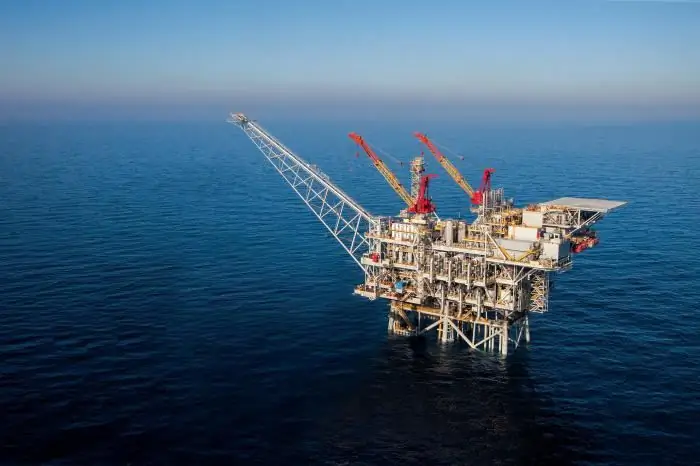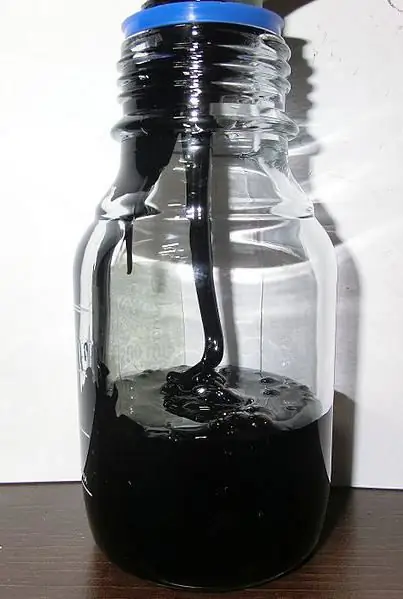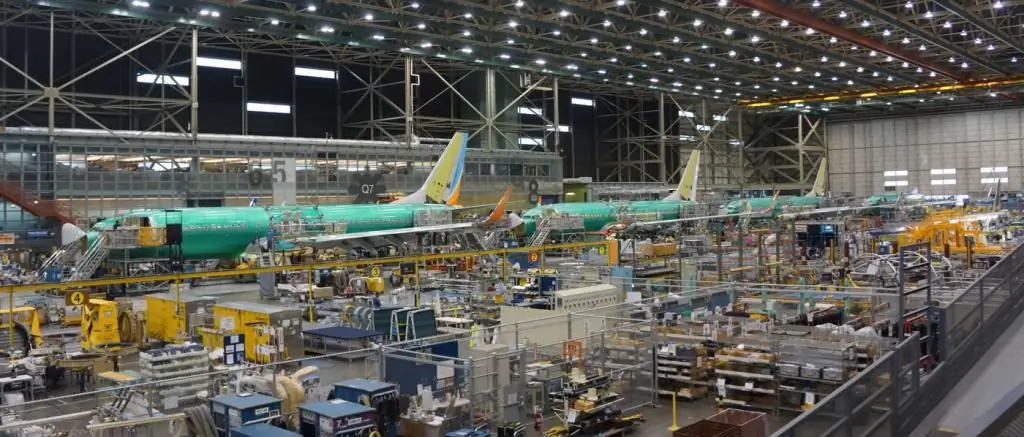2026 Author: Howard Calhoun | [email protected]. Last modified: 2025-01-24 13:10:45
The group of airlift methods of hydrocarbon production in oil and gas fields has long been used by the domestic industry as an alternative to flowing well development. This technology, under certain conditions of application, provides significant economic and technical advantages, but also requires the connection of additional resources. The optimal solution in most cases is the gas-lift method of oil production, in which a gas mixture is used as an active lifting medium. Such a solution justifies itself due to high performance, but also imposes additional organizational requirements in terms of security. For this reason, the method is used mostly by large organizations with a sufficient resource base.
General characteristics of the gas lift method of oil production

The principles of airlift, that is, the technology of lifting the well resources of an underground deposit, were first used at the end of the 18th century. The emergence of the idea of this method was due to the rapid development of mining technologies, but for a long time its full use was limited by the lack of sufficiently developed compressor equipment. The author of the gas-lift method of oil production is the German engineer Karl Loscher, who put forward a general scheme for raising resources using the energy of air mixtures. In the future, the technique has repeatedly been subjected to optimization, modernization and improvement in certain aspects of operation. The practical use of an airlift on an industrial scale with the creation of a theoretical basis for its technical implementation began only in the 20th century. In oil fields, the first experience of using gas lift dates back to 1985.
In our time, the use of gas lift technology justifies itself mainly in wells with high flow rates. Also, in conditions of high impurity content, gas lift is the most economical solution for lifting the resource to the surface. This applies primarily to oil mixtures that contain s alts, resins and paraffins, which make it difficult to lift masses. Regarding the comparison with the airlift as such, it can be said that the gas lift method of oil production is a continuation of the general technology of artificial lifting of liquids. Only if an air mixture is used as an active medium in a classic airlift, then a gaslift uses carbon-containing substances. For this reason, one of the key operationalcharacteristics of the technology consider the specific gas consumption. In the calculation of the cost of using a gas lift, the energy costs for the maintenance and supply of gas mixtures are about 30% of the total cost of projects.
Scope of application of the gas-lift method of oil production

A high-yielding well with high bottomhole pressure is a target place for the introduction of gas lift. Such deposits are a favorable environment for the organization of airlift in principle. But the practice of limiting flowing methods of oil production also determines a number of conditions under which gas lift becomes the only possible method of working on a well. At least, the general characteristic of the gas-lift method of oil production as the most adapted to dynamically unbalanced hydraulic environments allows it to be used in bottomholes with low saturation pressure and in sand wells with hard-to-reach installation conditions for technical support. For example, a gas lift system can be used in flood conditions, in swampy areas, or where there is a risk of flooding. Pressure indicators, by the way, can be artificially equalized by means of compressor equipment - although the rise depends on the well gas energy indicators, it can be quite adjusted to current needs.
On the other hand, if there is no centralized supply of technical and gas materials with a high level of mechanization of the production process, then it is better to use the traditional fountain schememining. As in the case of the airlift, the gas lift method of oil production is a continuation of the technology of the flowing method, but in an augmented version. It is the technological expansion of the production infrastructure that does not allow applying this method to small wells, the operation of which is calculated for short periods.

Technological production process
After the development of the well, the structural basis of the tip is formed on the surface, which later acts as a platform for organizing the main work processes. In the niche of the wellbore, a closed tunnel is organized with chambers and transitional valves that act as a resource flow regulator. The movement of the produced fluid up the channel is the main operational process, which is supported by the gasified medium in the bottom hole. To ensure gasification, a chamber with a nozzle for supplying the active mixture is lowered down parallel to the channel along an isolated circuit. Actually, the principle of the gas-lift method of oil production is reduced to the direction of gas into the liquid medium of the target resource, after which the lifting process must take place. It is important to note that enrichment with gas-air mixtures by itself does not ensure the liquid rise. For this operation, special pumps are used. The lifting force depends on both the degree of gasification and the power of the pump, both of which can be adjusted. For complex control of pressure indicators in the circuit, a compressor unit located on the surface is used.
Production intensityresource can be controlled by manual mechanics or automatic systems with electronic sensors. The operating parameters are set according to the capabilities of the receiving equipment. A feature of the gas-lift method of oil production is a special treatment after the extraction of the resource. Since the liquid rises along with the gas mixture, a special separation is required, after which the already purified oil is sent to a special sump. Moreover, since gas lift is often used in environments with high slurry contamination, multi-stage coarse filtration may be required before the resource enters the temporary storage tank.
Applied equipment

The entire technical infrastructure is formed by two groups of equipment - universal devices and devices for organizing well maintenance processes and special installations that are used in the operation of gas lift. The first group can include pumping circulation equipment, casing equipment, mounting hardware, metal pipes for pumping, etc. As a rule, both flowing and gas-lift methods of oil production are built on this equipment with minor structural differences.
As for the special technical elements for the realization of oil-gas-powered lifting, they are as follows:
- Compressor. Installation for maintenance of optimum pressure by injection of compressed air. Mostly industrial high-power units are used,capable of adjusting the parameters of the working value in a wide range.
- Gas lift chamber. It can be said that it is the core of the infrastructure for gas-lift oil production, in which the main processes of directing the flow, distribution and supply of gas-air mixtures take place. This is a metal structure with branch pipes and outlet channels, the operation of which is regulated by shutoff valves.
- Valves. In this system, the valve performs not only the function of blocking the circulation of the liquid medium, but also acts as a flow regulator. Gas lift valves are used at different levels of the hole, which allows more precise control of the production rate. The main design feature of such valves can be called the presence of sensitive elements that record pressure indicators with high accuracy and change their state depending on the force of impact in the control area.
Gas lift
In this case, the concept of a lift reflects the complex infrastructure of a gas lift submerged in a well. Its concept contains two channels - for gas injection and for lifting the target liquid resource. Both channels are organized using metal pipes, but they do not have to be joined to each other in parallel. Moreover, sometimes an angular direction of the gas supply pipe is provided, which is determined by the specifics of connecting the pumping unit. The configuration of pipe placement depends on the conditions under which the gas-lift method of oil production is organized. The photo below illustrates modern technology.the use of a combined injection and recovery string in one circuit with a diameter of 90 to 140 mm. In this case, regardless of the configuration of the direction of the channels, both from the upper part at the head and in the lower region of the shoe, if possible, rigid fixation of the structure is provided. The pipes may also have technological holes (perforation) for the release of sand and other foreign particles.

Gas lift operation without compressor
The supply of gas and the regulation of pressure indicators, in principle, does not have to be carried out with the support of compressor equipment. If gas and oil fields are located within the same operating site, then downhole gas lift can be organized on its own energy support without a compressor. But even in this case, the technologies of flowing and gas-lift oil production will diverge, since the exclusion of regulation by compressed air from the outside does not exclude the control of pressure indicators from natural gas. Moreover, under such conditions, it is possible to carry out downhole drying and preliminary cleaning of the resource, which reduces the cost of the technological process.
Gas lift process controls
First of all, it is worth emphasizing that gas lift requires the use of a wide range of measuring devices that allow you to keep important performance indicators under control. These include pressure, temperature, humidity and gas flow. The direct control of oil production in the gas lift method is carried out using the above-mentioned valves andshut-off valves with drive systems powered by generators on the surface. More advanced plants operate under the control of automatic controls, without the participation of operators, adjusting the parameters of gasification and the rate of recovery of resources.

Advantages of Technology
In terms of technical implementation, the method is rather laborious and costly, but it has a number of positive properties that justify its use:
- High performance.
- Wide opportunities for structural adjustment to external operating conditions and well parameters.
- Reliability and safety of the mining process.
- Flexibility. This property reflects both the advantages and disadvantages of the gas-lift method of oil production, which are manifested in various aspects of its application. For example, from the point of view of a qualified operator, the control process itself is quite simple and practically does not require physical effort. But, maintenance personnel are dealing with complex machinery that requires a lot of labor and cost to maintain.
- Most of the critical equipment is located on the surface.
- Universality of the method.
Flaws of technology
However, this method cannot be called optimally suitable for all fields, if we take into account the totality of operational factors, as well as environmental and economic aspects. To the negative aspects of using the gas lift methodoil production include:
- High costs of energy resources. We are talking about the injection of gas in industrial volumes, and the cost of fuel for generators that provide the functions of pumping equipment with compressors.
- Investment may not match the value of recovered oil and gas materials - especially considering the cost of additional process cleaning and separation processes.
- As large deposits are exploited, production volumes are decreasing, while the level of organizational and technical support should remain the same.
Conclusion

The experience of oil and gas producing companies shows that about half of the costs of projects for the development and operation of fields falls on the organization of technical infrastructure with support for additional workflows. It would seem that industry development trends should move progress towards the structural optimization of such events, but the gas lift method proves the opposite. As Karl Locher, the author of the gas-lift method of oil production, suggested, the connection of auxiliary energy sources during lifting reduces the energy consumption of the working operation, but not the organization of the event as a whole. In any case, the equipment for the lift string does not so much provide benefits in the form of connecting a gasification channel, but opens up more opportunities in controlling the parameters of the production process. And this advantage is precisely the prospect of developing gas lift as a way thatcan expand the possibilities of combining several development reservoirs into one high-capacity production facility.
Recommended:
Hoskold method, Ring method, Inwood method - ways to recover investment capital

When a person invests his own money in an income-generating object, he expects not only to receive profit from the invested capital, but also to fully repay it. This can be done through resale or by obtaining such profits that not only bring interest, but also gradually return investments
Gas production. Gas production methods. Gas production in Russia

Natural gas is formed by mixing various gases in the earth's crust. In most cases, the depth of occurrence ranges from several hundred meters to a couple of kilometers. It is worth noting that gas can form at high temperatures and pressures. In this case, there is no access of oxygen to the place. To date, gas production has been implemented in several ways, each of which we will consider in this article. But let's talk about everything in order
Oil is a mineral. Oil deposits. Oil production

Oil is one of the world's most important minerals (hydrocarbon fuel). It is a raw material for the production of fuels, lubricants and other materials
Flow methods of production organization: parameters, characteristics and standards. The need for this method in production

Today, in-line production is the most progressive form of organization of the production system. Optimal speed of work, minimum labor intensity and maximum quality of production - this is not a complete list of the advantages of the method under consideration
Oil production in the world. Oil production in the world (table)

The world as we know it would be very different if there was no oil. It is hard to imagine how many everyday things are created from oil. Synthetic fibers that make up clothing, all plastic used in everyday life and industry, medicines, cosmetics - all this is created from oil. Almost half of the energy consumed by mankind is produced from oil. It is consumed by aircraft engines, as well as almost all vehicles in the world

